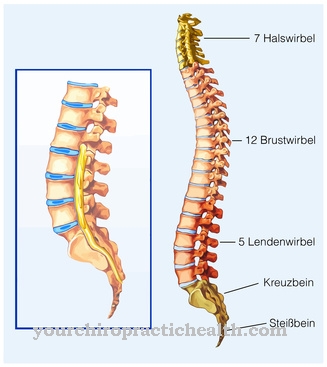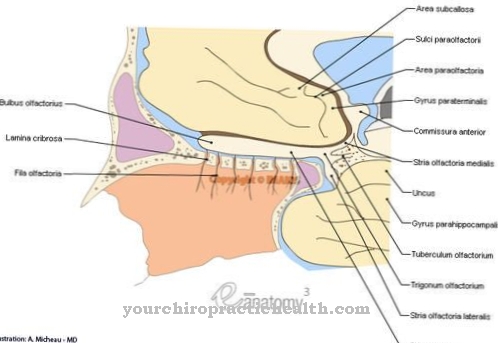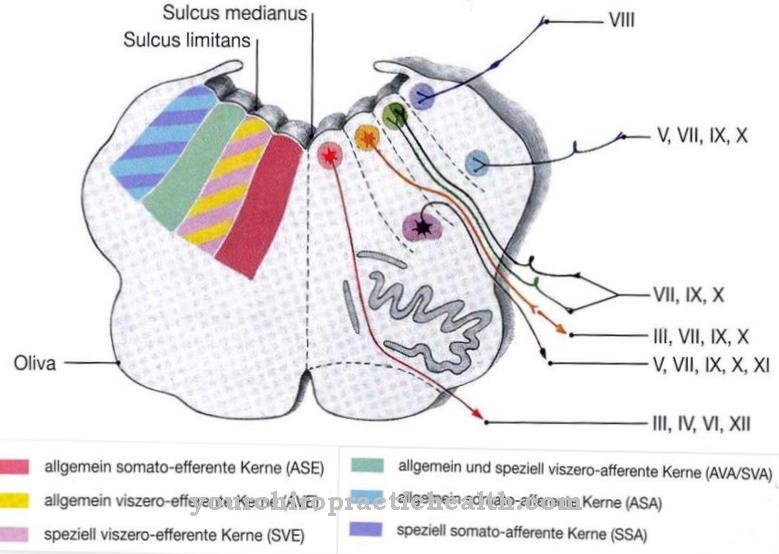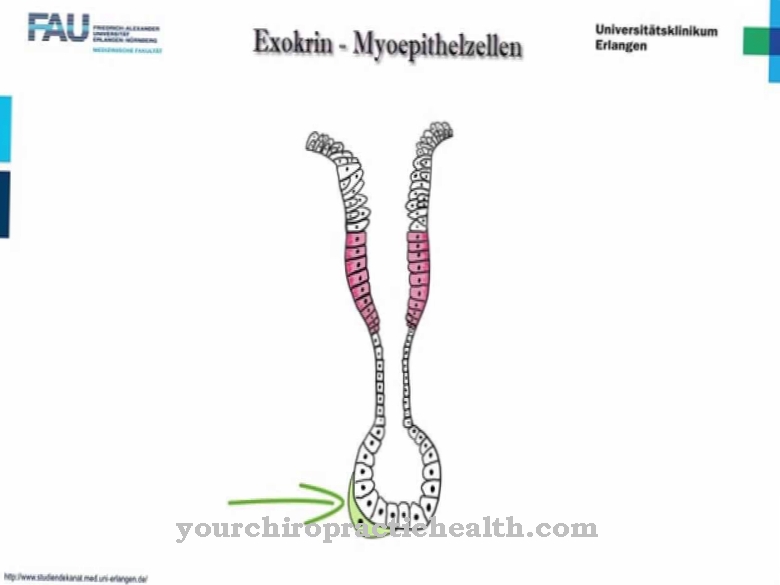Of the Inferior alveolar nerve is found in the lower jaw and contains sensitive fibers that are responsible for the teeth, chin and lower lip. In addition, the inferior alveolar nerve includes a motor branch that controls the mylohyoid muscle and the digastric muscle. Dentistry partly uses the nerve tract for local anesthesia (conduction anesthesia).
What is the inferior alveolar nerve?
The inferior alveolar nerve is a branch of the mandibular nerve that begins at the trigeminal nerve, the 5th cranial nerve. The semilunar ganglion switches the fibers to postganglionic nerve cells.
This nerve cord leaves the cranial cavity as the mandibular nerve through the oval opening (foramen ovale) and reaches the lower pit of the temple (infratemporal fossa), which is located in the vicinity of the large wing of the sphenoid bone (ala major ossis sphenoidalis). Several branches of the mandibular nerve branch off at this point, including the inferior alveolar nerve. It belongs to the peripheral nerves and consists of both sensitive nerve fibers that transmit information such as pressure and pain to the brain, and motor nerve fibers that control muscles. The inferior alveolar nerve is identical to the alveolar nerve of the lower jaw.
Anatomy & structure
The inferior alveolar nerve has four branches. One of these, the mylohyoid nerve, provides both the mylohyoid and digastric muscles with movement control commands.
The rami dentales or tooth branches lead to the roots of the teeth. In addition, the fibers from this branch participate in the inferior dental plexus. The other nerve tracts of this plexus originate from the inferior gingival rami, which extend from the inferior dental plexus to the gums (gingiva). The third branch of the inferior alveolar nerve is the incisive ramus, which also consists of sensitive nerve fibers and innervates the anterior teeth.
The inferior alveolar nerve begins at the mandibular nerve and runs under the outer wing muscle (lateral pterygoid muscle). This muscle is supplied by another branch of the mandibular nerve - namely the lateral pterygoid nerve. The inferior alveolar nerve then moves to the mandibular foramen and shortly thereafter merges into the mandibular canal (canalis mandibulae). Its course leads the inferior aveolar nerve to the mental foramen. As the fourth branch, the mental nerve branches off from the inferior alveolar nerve. It is also known as the chin nerve and extends to the lower lip.
Function & tasks
The inferior alveolar nerve is a mixed nerve with motor and sensory fibers. The latter make up the greater part, as they divide into three branches of the nerve, while only one branch of the inferior alveolar nerve is responsible for controlling muscles. The motor branch is the mylohyoid nerve.
It controls the mylohyoid muscle, which is also called the jaw-hyoid bone muscle in German. The muscle participates in opening the mouth on the one hand and swallowing on the other. In addition, it forms a large part of the floor of the mouth. The digastric muscle is also dependent on the neuronal supply from the mylohyoid nerve. The digastric muscle has two bellies and is also involved in opening the mouth and swallowing. The facial nerve also supplies part of the muscle.
The sensitive branches of the inferior alveolar nerve transmit the irritation from the tooth roots, gums and lower lip to the central nervous system. The Rami dentales are responsible for the posterior teeth. The third branch of the inferior alveolar nerve is the incisive branch. Like the Rami dentales, it is responsible for conveying somatosensitive information about the teeth - but in contrast to the Rami dentales, the Ramus incisivus is responsible for the incisors (Dentes incisivi) and the canines (Dens caninus) on the corresponding side of the body.
The fourth and last branch of the inferior alveolar nerve is represented by the mental nerve, which also has several branches. With them, the nerve reaches the lower lip and absorbs information such as pressure, vibration, touch, pain and temperature. The sensations in this case come from both the skin of the lower lip and the mucous membrane.
You can find your medication here
➔ Toothache medicationDiseases
In dentistry, the inferior alveolar nerve is one of several ways to perform local anesthesia.
To do this, the dentist injects a suitable drug that causes the nerve to temporarily fail. The sensitive nerve tracts can no longer transmit signals - and accordingly the patient does not feel any pain when the dentist is working on the teeth. This type of anesthesia is what is known as conduction anesthesia.
An unwanted failure of the inferior alveolar nerve is possible after an injury, for example. In this case too, tissue numbness is possible. Medicine calls this condition paresthesia. Paresthesia can also manifest itself as a tingling sensation, falling asleep, or a disruption in the perception of warmth and cold.
As a result of a lesion of the inferior alveolar nerve, difficulties opening the jaw and difficulty swallowing are possible. More common than damage that only affects the inferior alveolar nerve are neurological problems at a higher level, for example in the mandibular nerve or the trigeminal nerve. In addition to injuries, the numerous possible causes also include tumors, inflammation, bleeding, bruises and neurodegenerative diseases that affect the sensitive nuclei in the brain stem.












.jpg)



.jpg)










.jpg)
